Analysis of Individual Attitudes and Behaviors in the Workplace Essay
VerifiedAdded on 2021/04/17
|5
|1142
|275
Essay
AI Summary
This essay analyzes the impact of individual attitudes and behaviors on workplace dynamics, drawing from the article by Kim et al. (2017) on voluntary workplace green behavior. It explores how factors like job satisfaction, organizational commitment, and corporate social responsibility influence employee actions. The essay highlights the relationship between individual attitudes and workplace behavior, emphasizing the importance of employee motivation and ethical considerations. The study utilizes primary data analysis to examine the influence of leadership behavior, coworker advocacy, and individual differences on employee engagement in green initiatives. The essay concludes that individual attitudes directly impact workplace behavior and are crucial for organizational performance and social responsibility.
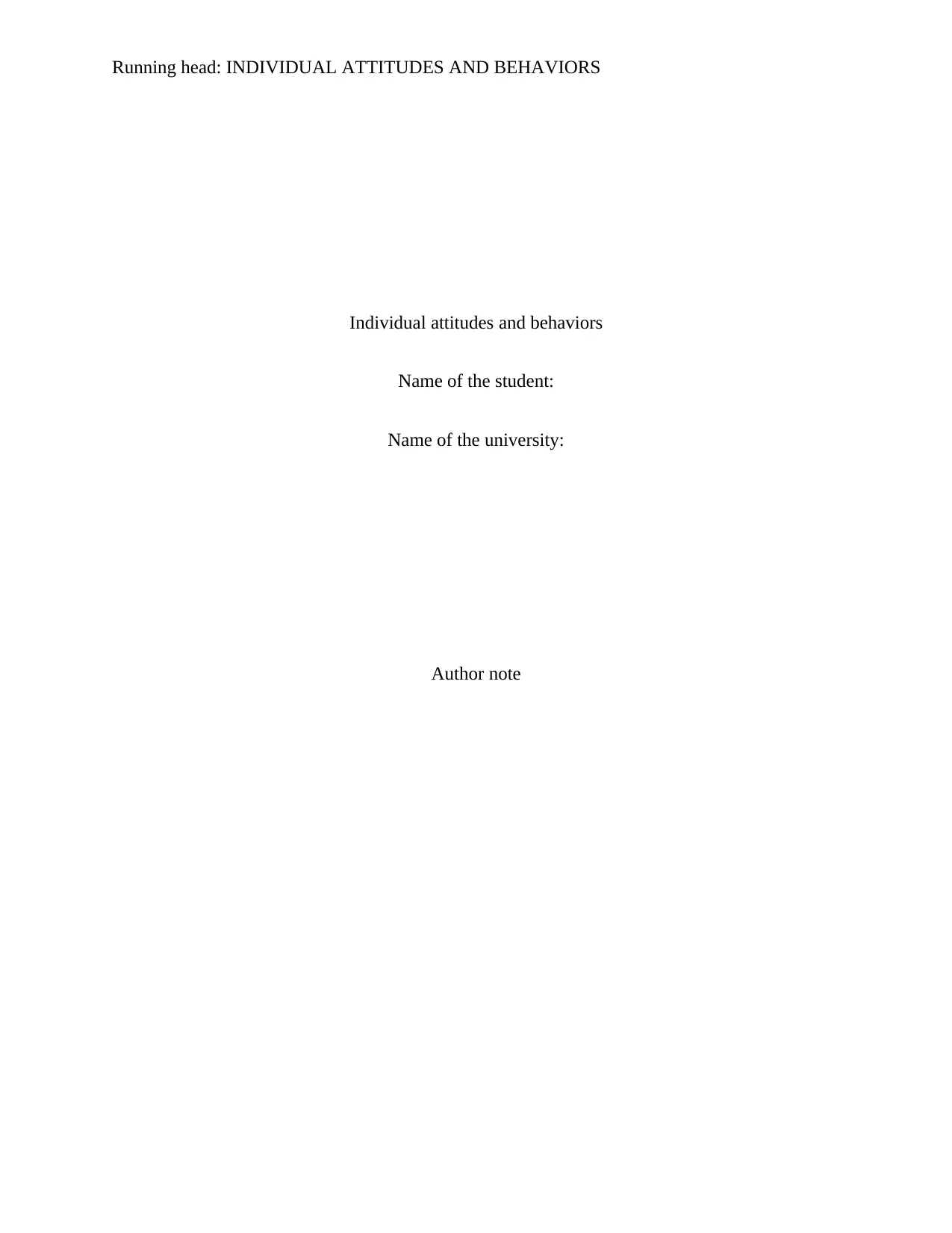
Running head: INDIVIDUAL ATTITUDES AND BEHAVIORS
Individual attitudes and behaviors
Name of the student:
Name of the university:
Author note
Individual attitudes and behaviors
Name of the student:
Name of the university:
Author note
Paraphrase This Document
Need a fresh take? Get an instant paraphrase of this document with our AI Paraphraser
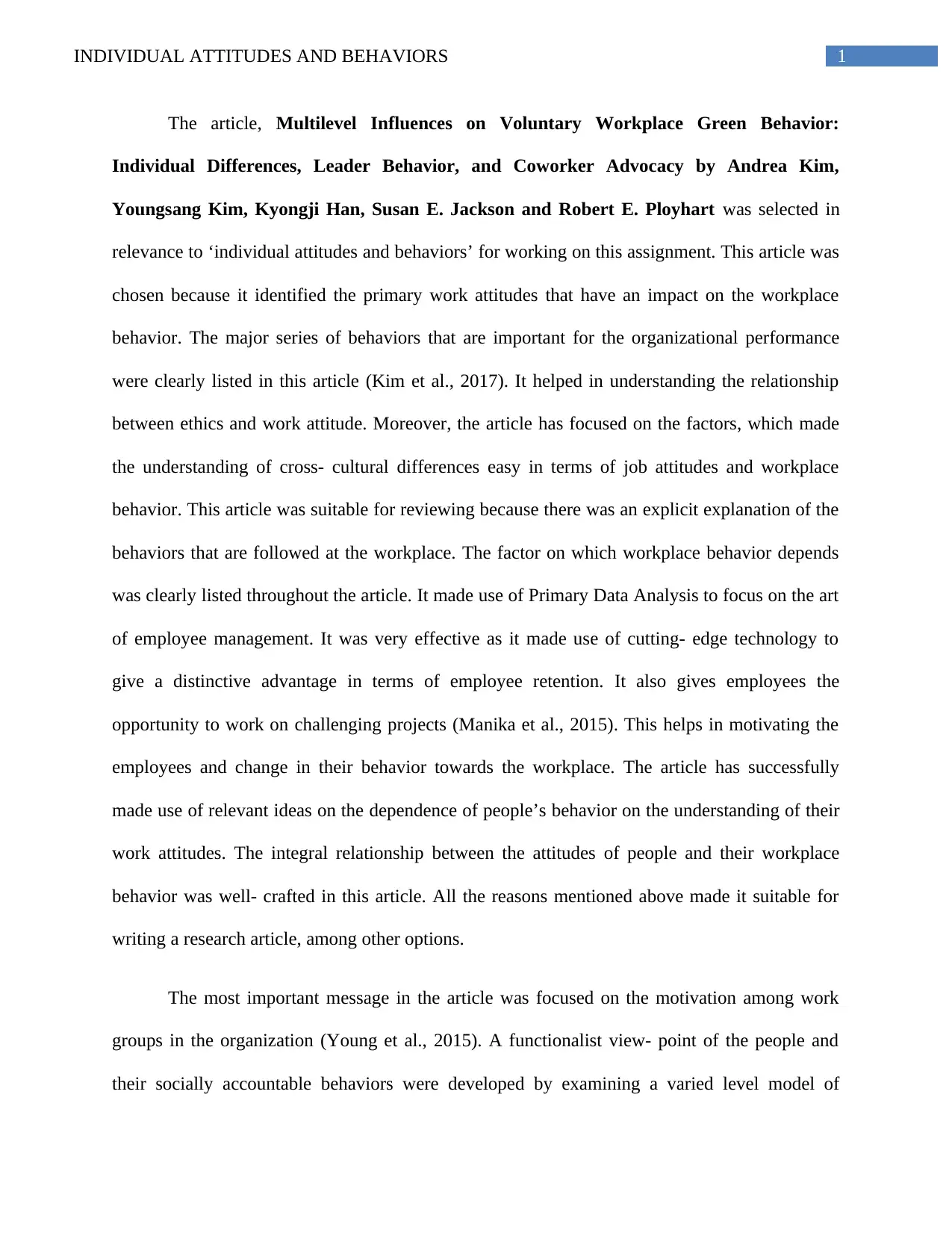
1INDIVIDUAL ATTITUDES AND BEHAVIORS
The article, Multilevel Influences on Voluntary Workplace Green Behavior:
Individual Differences, Leader Behavior, and Coworker Advocacy by Andrea Kim,
Youngsang Kim, Kyongji Han, Susan E. Jackson and Robert E. Ployhart was selected in
relevance to ‘individual attitudes and behaviors’ for working on this assignment. This article was
chosen because it identified the primary work attitudes that have an impact on the workplace
behavior. The major series of behaviors that are important for the organizational performance
were clearly listed in this article (Kim et al., 2017). It helped in understanding the relationship
between ethics and work attitude. Moreover, the article has focused on the factors, which made
the understanding of cross- cultural differences easy in terms of job attitudes and workplace
behavior. This article was suitable for reviewing because there was an explicit explanation of the
behaviors that are followed at the workplace. The factor on which workplace behavior depends
was clearly listed throughout the article. It made use of Primary Data Analysis to focus on the art
of employee management. It was very effective as it made use of cutting- edge technology to
give a distinctive advantage in terms of employee retention. It also gives employees the
opportunity to work on challenging projects (Manika et al., 2015). This helps in motivating the
employees and change in their behavior towards the workplace. The article has successfully
made use of relevant ideas on the dependence of people’s behavior on the understanding of their
work attitudes. The integral relationship between the attitudes of people and their workplace
behavior was well- crafted in this article. All the reasons mentioned above made it suitable for
writing a research article, among other options.
The most important message in the article was focused on the motivation among work
groups in the organization (Young et al., 2015). A functionalist view- point of the people and
their socially accountable behaviors were developed by examining a varied level model of
The article, Multilevel Influences on Voluntary Workplace Green Behavior:
Individual Differences, Leader Behavior, and Coworker Advocacy by Andrea Kim,
Youngsang Kim, Kyongji Han, Susan E. Jackson and Robert E. Ployhart was selected in
relevance to ‘individual attitudes and behaviors’ for working on this assignment. This article was
chosen because it identified the primary work attitudes that have an impact on the workplace
behavior. The major series of behaviors that are important for the organizational performance
were clearly listed in this article (Kim et al., 2017). It helped in understanding the relationship
between ethics and work attitude. Moreover, the article has focused on the factors, which made
the understanding of cross- cultural differences easy in terms of job attitudes and workplace
behavior. This article was suitable for reviewing because there was an explicit explanation of the
behaviors that are followed at the workplace. The factor on which workplace behavior depends
was clearly listed throughout the article. It made use of Primary Data Analysis to focus on the art
of employee management. It was very effective as it made use of cutting- edge technology to
give a distinctive advantage in terms of employee retention. It also gives employees the
opportunity to work on challenging projects (Manika et al., 2015). This helps in motivating the
employees and change in their behavior towards the workplace. The article has successfully
made use of relevant ideas on the dependence of people’s behavior on the understanding of their
work attitudes. The integral relationship between the attitudes of people and their workplace
behavior was well- crafted in this article. All the reasons mentioned above made it suitable for
writing a research article, among other options.
The most important message in the article was focused on the motivation among work
groups in the organization (Young et al., 2015). A functionalist view- point of the people and
their socially accountable behaviors were developed by examining a varied level model of
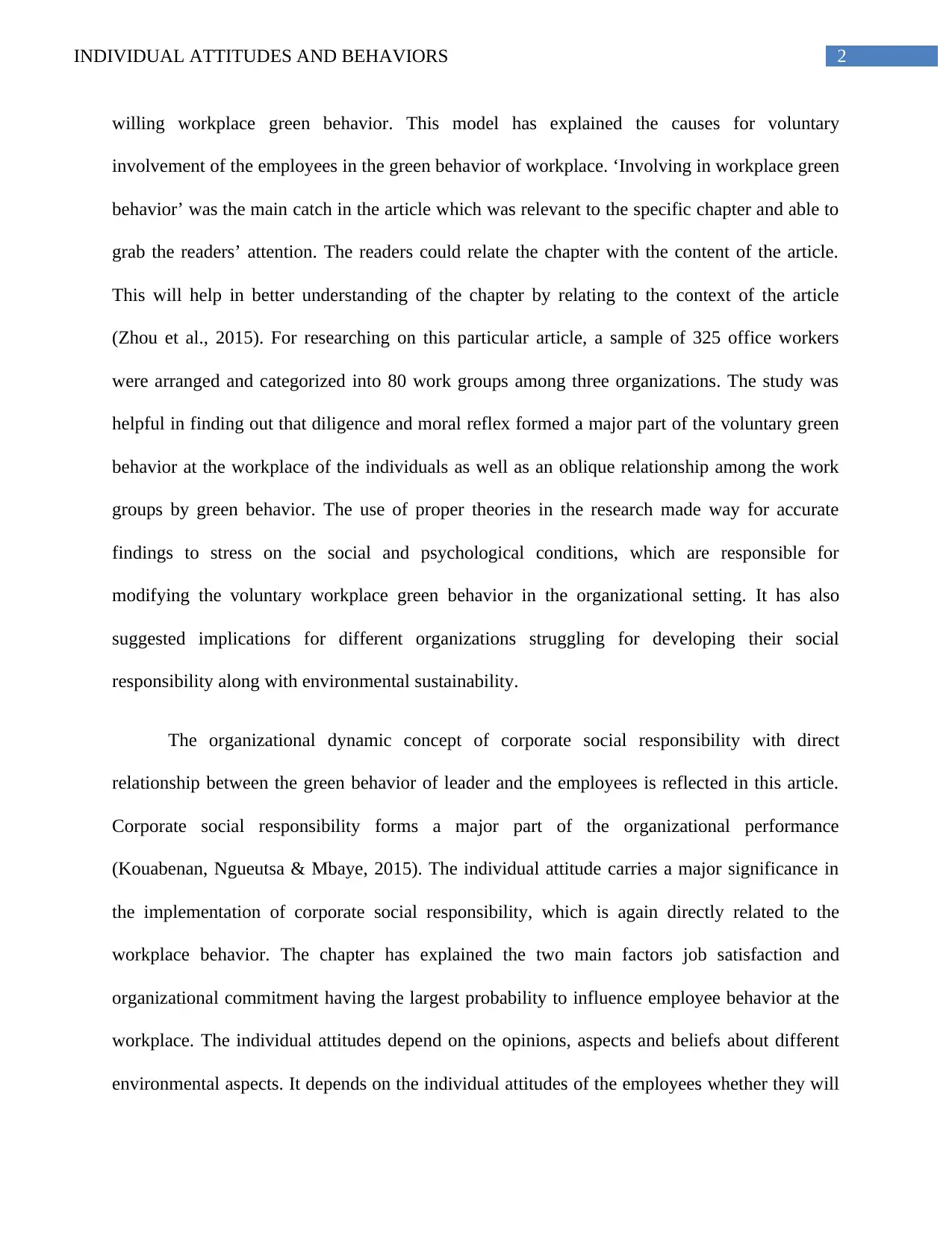
2INDIVIDUAL ATTITUDES AND BEHAVIORS
willing workplace green behavior. This model has explained the causes for voluntary
involvement of the employees in the green behavior of workplace. ‘Involving in workplace green
behavior’ was the main catch in the article which was relevant to the specific chapter and able to
grab the readers’ attention. The readers could relate the chapter with the content of the article.
This will help in better understanding of the chapter by relating to the context of the article
(Zhou et al., 2015). For researching on this particular article, a sample of 325 office workers
were arranged and categorized into 80 work groups among three organizations. The study was
helpful in finding out that diligence and moral reflex formed a major part of the voluntary green
behavior at the workplace of the individuals as well as an oblique relationship among the work
groups by green behavior. The use of proper theories in the research made way for accurate
findings to stress on the social and psychological conditions, which are responsible for
modifying the voluntary workplace green behavior in the organizational setting. It has also
suggested implications for different organizations struggling for developing their social
responsibility along with environmental sustainability.
The organizational dynamic concept of corporate social responsibility with direct
relationship between the green behavior of leader and the employees is reflected in this article.
Corporate social responsibility forms a major part of the organizational performance
(Kouabenan, Ngueutsa & Mbaye, 2015). The individual attitude carries a major significance in
the implementation of corporate social responsibility, which is again directly related to the
workplace behavior. The chapter has explained the two main factors job satisfaction and
organizational commitment having the largest probability to influence employee behavior at the
workplace. The individual attitudes depend on the opinions, aspects and beliefs about different
environmental aspects. It depends on the individual attitudes of the employees whether they will
willing workplace green behavior. This model has explained the causes for voluntary
involvement of the employees in the green behavior of workplace. ‘Involving in workplace green
behavior’ was the main catch in the article which was relevant to the specific chapter and able to
grab the readers’ attention. The readers could relate the chapter with the content of the article.
This will help in better understanding of the chapter by relating to the context of the article
(Zhou et al., 2015). For researching on this particular article, a sample of 325 office workers
were arranged and categorized into 80 work groups among three organizations. The study was
helpful in finding out that diligence and moral reflex formed a major part of the voluntary green
behavior at the workplace of the individuals as well as an oblique relationship among the work
groups by green behavior. The use of proper theories in the research made way for accurate
findings to stress on the social and psychological conditions, which are responsible for
modifying the voluntary workplace green behavior in the organizational setting. It has also
suggested implications for different organizations struggling for developing their social
responsibility along with environmental sustainability.
The organizational dynamic concept of corporate social responsibility with direct
relationship between the green behavior of leader and the employees is reflected in this article.
Corporate social responsibility forms a major part of the organizational performance
(Kouabenan, Ngueutsa & Mbaye, 2015). The individual attitude carries a major significance in
the implementation of corporate social responsibility, which is again directly related to the
workplace behavior. The chapter has explained the two main factors job satisfaction and
organizational commitment having the largest probability to influence employee behavior at the
workplace. The individual attitudes depend on the opinions, aspects and beliefs about different
environmental aspects. It depends on the individual attitudes of the employees whether they will
⊘ This is a preview!⊘
Do you want full access?
Subscribe today to unlock all pages.

Trusted by 1+ million students worldwide
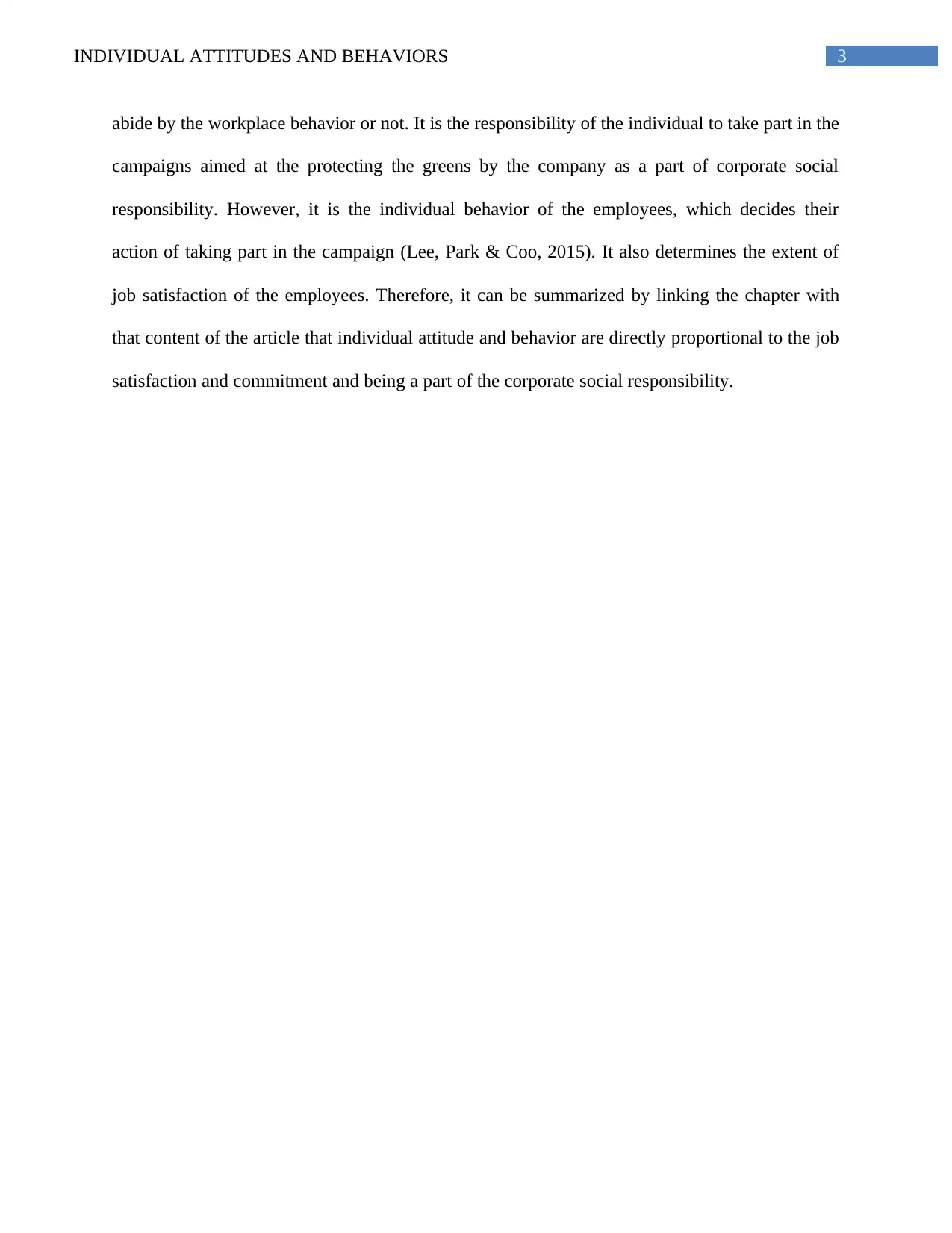
3INDIVIDUAL ATTITUDES AND BEHAVIORS
abide by the workplace behavior or not. It is the responsibility of the individual to take part in the
campaigns aimed at the protecting the greens by the company as a part of corporate social
responsibility. However, it is the individual behavior of the employees, which decides their
action of taking part in the campaign (Lee, Park & Coo, 2015). It also determines the extent of
job satisfaction of the employees. Therefore, it can be summarized by linking the chapter with
that content of the article that individual attitude and behavior are directly proportional to the job
satisfaction and commitment and being a part of the corporate social responsibility.
abide by the workplace behavior or not. It is the responsibility of the individual to take part in the
campaigns aimed at the protecting the greens by the company as a part of corporate social
responsibility. However, it is the individual behavior of the employees, which decides their
action of taking part in the campaign (Lee, Park & Coo, 2015). It also determines the extent of
job satisfaction of the employees. Therefore, it can be summarized by linking the chapter with
that content of the article that individual attitude and behavior are directly proportional to the job
satisfaction and commitment and being a part of the corporate social responsibility.
Paraphrase This Document
Need a fresh take? Get an instant paraphrase of this document with our AI Paraphraser
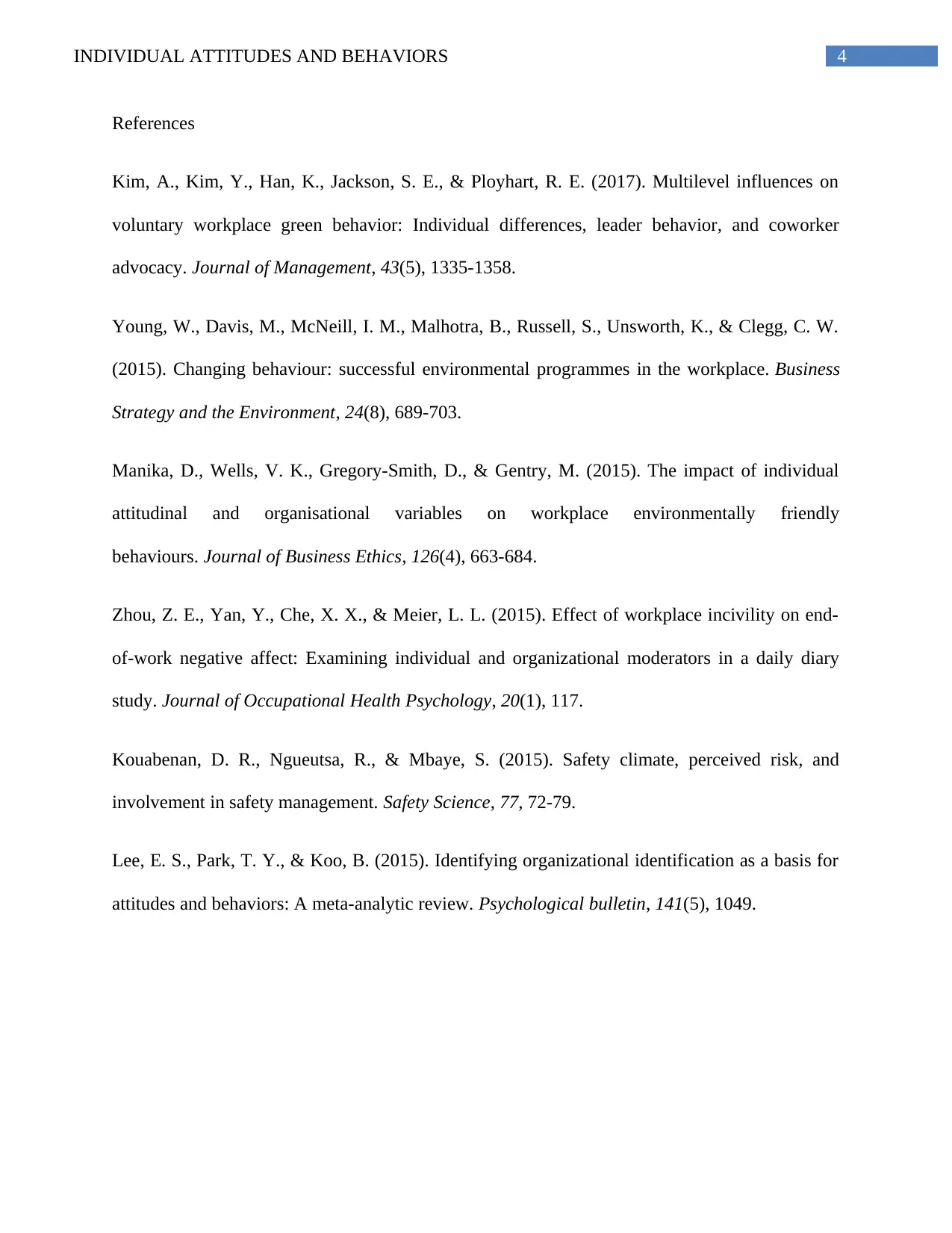
4INDIVIDUAL ATTITUDES AND BEHAVIORS
References
Kim, A., Kim, Y., Han, K., Jackson, S. E., & Ployhart, R. E. (2017). Multilevel influences on
voluntary workplace green behavior: Individual differences, leader behavior, and coworker
advocacy. Journal of Management, 43(5), 1335-1358.
Young, W., Davis, M., McNeill, I. M., Malhotra, B., Russell, S., Unsworth, K., & Clegg, C. W.
(2015). Changing behaviour: successful environmental programmes in the workplace. Business
Strategy and the Environment, 24(8), 689-703.
Manika, D., Wells, V. K., Gregory-Smith, D., & Gentry, M. (2015). The impact of individual
attitudinal and organisational variables on workplace environmentally friendly
behaviours. Journal of Business Ethics, 126(4), 663-684.
Zhou, Z. E., Yan, Y., Che, X. X., & Meier, L. L. (2015). Effect of workplace incivility on end-
of-work negative affect: Examining individual and organizational moderators in a daily diary
study. Journal of Occupational Health Psychology, 20(1), 117.
Kouabenan, D. R., Ngueutsa, R., & Mbaye, S. (2015). Safety climate, perceived risk, and
involvement in safety management. Safety Science, 77, 72-79.
Lee, E. S., Park, T. Y., & Koo, B. (2015). Identifying organizational identification as a basis for
attitudes and behaviors: A meta-analytic review. Psychological bulletin, 141(5), 1049.
References
Kim, A., Kim, Y., Han, K., Jackson, S. E., & Ployhart, R. E. (2017). Multilevel influences on
voluntary workplace green behavior: Individual differences, leader behavior, and coworker
advocacy. Journal of Management, 43(5), 1335-1358.
Young, W., Davis, M., McNeill, I. M., Malhotra, B., Russell, S., Unsworth, K., & Clegg, C. W.
(2015). Changing behaviour: successful environmental programmes in the workplace. Business
Strategy and the Environment, 24(8), 689-703.
Manika, D., Wells, V. K., Gregory-Smith, D., & Gentry, M. (2015). The impact of individual
attitudinal and organisational variables on workplace environmentally friendly
behaviours. Journal of Business Ethics, 126(4), 663-684.
Zhou, Z. E., Yan, Y., Che, X. X., & Meier, L. L. (2015). Effect of workplace incivility on end-
of-work negative affect: Examining individual and organizational moderators in a daily diary
study. Journal of Occupational Health Psychology, 20(1), 117.
Kouabenan, D. R., Ngueutsa, R., & Mbaye, S. (2015). Safety climate, perceived risk, and
involvement in safety management. Safety Science, 77, 72-79.
Lee, E. S., Park, T. Y., & Koo, B. (2015). Identifying organizational identification as a basis for
attitudes and behaviors: A meta-analytic review. Psychological bulletin, 141(5), 1049.
1 out of 5
Related Documents
Your All-in-One AI-Powered Toolkit for Academic Success.
+13062052269
info@desklib.com
Available 24*7 on WhatsApp / Email
![[object Object]](/_next/static/media/star-bottom.7253800d.svg)
Unlock your academic potential
Copyright © 2020–2025 A2Z Services. All Rights Reserved. Developed and managed by ZUCOL.





